

|
A r t i c l e s A n d C a s e
S t u d i e s
Chiron Riding Clinic Report
(click on images for larger view)
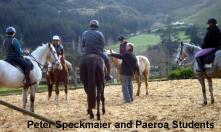
Leading German riding instructor Peter Speckmaier held three-day riding clinics in Christchurch and Paeroa,
New Zealand in July 2004, teaching the Chiron method of riding.
What is Chiron?
Chiron is a Greek word that simply means "Centaur". Mr Speckmaier is one of the few qualified Chiron instructors in the world. He was certified by the late Rolf Becher, one of Germany's top showjumping riders, who rode successfully according to Caprilli's original teachings. Chiron riding is used for jumping, muscle development in young horses, including dressage horses, and rehabilitation of horses with atrophied back and neck muscles.
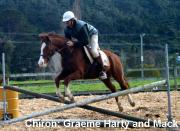
The Chiron Clinic
Riders were taught the classical forward jumping style of riding as first discovered by Italian military rider Caprilli in the early 1900s. Non-riding participants also attended the clinic, which involved intensive theory for half of each day about equine anatomy, psychology and the nervous system as well as a practical component for the other half of the day.
Mr Speckmaier said the Chiron course taught basic training and riding style and he was very pleased with the improvements in the horses and riders over the three day courses. The Chiron method of riding focuses on minimum interference with the horse so that the horse can better focus on the task and jump in a more natural style, he said.
The Forward Seat
The forward seat involves a good "foundation" of the rider's knee, calf, foot remaining solid on the horse, hips back, shoulders low and hands on the horses neck. Mr Speckmaier said it was best to use a neck strap and if the hands were about one hand's width below the crest and just in front of the shoulder blade, they would be resting on an acupressure point that calms the horse.
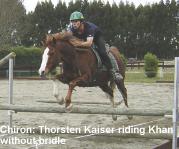
When the riders got into the correct position, the horses immediately responded by lowering their heads, stretching their necks forward into a nice frame and jumping in bascule, which is a rounded frame over the jump, a natural position for the horse that enables it to use its back properly.
Automatic Reflex
The practical sessions of the clinics worked on building an automatic "reflex" in the horse, based on no interference from the rider to allow the horse to use it's own initiative, balance and timing. The exercises that encouraged the automatic reflex in the horse included trotting cavaletti, an alley and combinations of low jumps in either a bounce or one canter stride, with the correct distance used between jumps to promote a steady rhythm for the horse. Once this automatic reflex was established, the horses knew what to do when faced into a jump or combination of jumps, and were confident, even if the distance between jumps was too little or too great, for example at competitions.

Keeping a good rhythm into the jumps and letting the horse know that the rider is sure about doing the task were key elements to success. In other words, building a "forward reflex".
Chiron Theory
In the theory portion, one of the things students learned that many modern jumping methods involved a two-point or light seat, often combined with contact with the horse's mouth, which Mr Speckmaier said is a tyle of riding more suited for other codes of riding, such as endurance, dressage, and trekking rather than jumping as it interfered too much withthe horse while jumping. Also, the modern method of checking the horse's stride before the jump broke the horse's rhythm and concentration and interfered with the horse so much that it could not jump in a proper bascule frame, resulting in the horse not being able to jump as high.
How many times have we seen even the top riders hold their horses in before a jump to "see the stride" just to let it go at the last minute and the horse hasn't had a chance to even see the jump let alone prepare for it? It also makes it more difficult for the horse to prepare for the jump and jump in bascule as it's head has been held high and the rider has been riding in the saddle or using a "driving" seat, preventing the horse from using it's back properly. The result is a horse that is not able to jump as accurately or as high.
Students learned that when ridden in the classical forward jumping style, the horse is not restrained before a jump and the rider is not bouncing on the horse's back or interfering with it's mouth. For this reason, the horse is able to concentrate on the jump more, jump up to half a metre higher because it can bascule, and remain less distressed and more sound long term. Horses also learn not to rush at jumps and are more willing and happier to perform, making it much easier and enjoyable for the horse and rider.
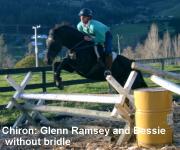
For example, during the clinic, one horse, called Bessie, which had been showjumped up to 1.2 metres and was difficult to control over and
between jumps (bolting, rushing etc), responded well to the Chiron style and was cantering over jumps with an
excellent rhythm and relaxed style without a bridle by the end of the second day. This was also the case with horses (and riders) who had never jumped before, and horses reluctant to go forward.
Chiron in Dressage
Mr Speckmaier said that the Chiron forward seat should be used to develop back and neck muscles in young dressage horses. The horses can only be asked to go into a good dressage position when they are strong enough. Young dressage horses that are ridden in a deep seat with contact on the mouth do not develop muscle very well, if not actually atrophy the back and neck muscles, he said. Young horses need to be ridden in a forward seat to develop muscle correctly, particularly over open country, which is also psychologically good for the horse.
Overbending the neck, a common mistake
Also, riding with contact on the horses mouth so that the horse is "overbent" or the head is tipped behind the vertical in any discipline is damaging to the horse. This is because the horse's neck vertebrae are "broken" or bent incorrectly, which affects the nervous system because the main spinal nerve is restricted in that area "like a hose with a kink in it". This can cause damage to the horse's vertebrae, nervous system, muscles, organs etc. This is also why side reins are damaging for the horse, as they encourage the horse to bend it's neck incorrectly when the head is low so that it's head is behind the vertical and it's neck "kinked".
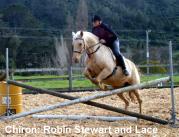
A better way to get a correct long and low frame for muscle development or rehabilitation is to get off the horses back by using a forward seat, and allow the horse to stretch its muscles by "hoovering" the ground, or stretching it's back and neck muscles by placing it's head very low. (My horse, which has loose lips, actually got sand in his mouth by doing this!). Mr Speckmaier said this was an excellent position for the horse to stretch and rest, for example, during a long endurance ride: the horse will do this for a rest then bring it's head up and be ready to work again.
Using Chiron for Rehabilitation
The Chiron style of riding is also used for successful rehabilitation of problem jumping horses and equine muscle development, particularly in the horse's back. We learned about a rehabilitation case, an ex-racehorse in Germany named "Cindy", which had such an atrophied back that when a bucket of water was thrown over her back, there were pools of water on each side of the spine. This horse had good hooves, natural lifestyle, good nutrition correctly fitted tack. The only thing that was incorrect was the riding style - the rider was doing dressage in a deep seat with contact on the mouth. After attending a basic three-day Chiron clinic with Mr Speckmaier, and rehabilitating the horse using the Chiron style of riding, the horse was unrecognisable a year later. The back muscles had developed normally, as had the neck and rump and the horse's eye was far softer and expression happier.
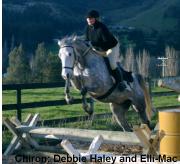
NB: This is an important point for those of us who are rehabilitating a horse that's been previously shod,
conventionally kept and trained in such a way that it has a lot of muscle wastage in it's back (NZ thoroughbreds from the track that often have very little muscle along their backs and necks are a good example). You may be able to get the horse sound and healthy due to proper hoofcare, nutrition and natural lifestyle, but the horse still lacks that topline muscle and nothing seems to work. Riding using the Chiron method will often be necessary for proper rehabilitation of these kinds of horses.
Chiron in New Zealand
We expect to have Peter Speckmaier back for basic and advanced Chiron clinics in both the North and South Islands in summer
2005. If you would like to attend, please register your interest with the Institute for Barefoot Equine Management, email:
ibem@ihug.co.nz
By Teresa Ramsey
(July 04)
Resources: The Centaur Reborn, Holistic Horsemanship and the Foundation for Optimal
Performance, by Peter Speckmaier and Sabine Kells. This excellent book includes an overview of the three-day Chiron training clinic, including exercises. Now
available from the Natural Hoof Shop
Submit an Article or Case Study
The more we share information, the better off our
horses are going to be. If you'd like to share your
story, please email the
editor.
Disclaimer: Natural Hoof
reserves the right to change or edit any part of
all articles and case studies submitted to this
website. Natural Hoof does not take any
responsibility for the content of any articles
and/or case studies and/or any misapplication of the information presented in any articles. Natural Hoof presumes readers consult a professional for more information about any topic covered in any Natural Hoof article.
Home | Articles | Hoof Trimmers | Clinics-Events | Brag | Classifieds |
Order | Links


|
|









